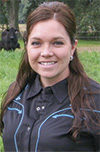Removing any female from your herd that is not performing in her environment (that is receiving adequate management conditions) is critical to being a profitable cattle producer.
Think of it this way: Cow A breeds this year, while Cow B does not. Why would you keep Cow B? It’s easy to justify Cow B’s lack of performance – she was young, it was a hard winter or she weaned a heavy calf. However, Cow A was subject to the exact same management and performed, yet Cow B did not. Cull Cow B and get another Cow A!
Financially in a commercial setting, it is nearly impossible for Cow B to ever overcome the loss of production value from that year. In 2016, the average annual operating cost per cow was $700. If retaining a 5-year-old cow that is expected to wean five more calves in her lifetime (weaning 500-pound calves at $1.40 per pound), she would need to wean an additional 100 pounds each year to pay for her “open” year, and in the words of Si Robinson: “That ain’t happening, Jack!”
In many cases, young cows are retained if they are open with the justification that “we have too much in her to get rid of her at this point.” This is in reference to the cost of replacement heifer development; however, salvage value on a young cow is much higher than an older cow. In addition, as mentioned above, she would need to wean an extra 71 pounds a year for the next seven years to pay for her open year.
With the added value of a purebred/seedstock calf, producers are more likely to be able to overcome the cost associated with retaining an open cow. But then we must ask ourselves, “Should seedstock producers be keeping open cows?” Ideally, cows that are subfertile would be culled from a herd, regardless of their ability to recoup the cost of their missed calf. While the short-term math is simple, allowing subfertility to exist within a herd, long term, will be extremely expensive. More concerning is a seedstock producer who is willing to allow subfertile cows to continue to contribute to their genetic foundation. Thus, it’s important to know the culling strategies of your seedstock producer, as it is key in making sound genetic decisions.
Having an understanding of how genetic progress is calculated helps drive home the importance of culling subperforming cows from our herd.
Genetic progress (see Figure 1) is a function of selection pressure, heritability and generation interval. Each component plays a different role in the genetic progress of your herd. However, progress cannot be made, nor production be maintained, if one component is missing.

Section differential:
Section differential is defined as the variance in the average genetics of animals selected for breeding and the average genetics of the remaining animals in the herd. The tighter the selection pressure, the greater genetic standard that is maintained. For example, selecting 20 replacement heifers from 100 versus selecting 45 replacement heifers. When you select a smaller proportion of the population, you are able to make more critical selection decisions, keeping better heifers.
Heritability:
Heritability is the proportion of measured difference between animals that can be attributed to genetic differences between animals and will be passed on to progeny. The higher the heritability of a trait, the greater the proportion of offspring that this trait will be passed on to from both parents, and therefore, the greater the genetic progress that will be achieved. In general, the closer to the end point (carcass) a trait is, the more heritable it is, whereas traits that are seen at the beginning of the production chain, such as maternal traits, are less heritable (see Figure 2). Keep in mind that maternal traits are strongly influenced by moderate to highly heritable traits. That is why culling influences fertility and certain cow families tend to thrive under certain management conditions, while others struggle.

Generation interval:
Generation interval is the lone denominator in the equation for genetic progress, giving it the greatest impact on genetic progress. Defined as the average age of the parents of a herd at the time of their offspring’s birth, a short generation length means that animals selected for breeding are mated in the herd at a younger average age. Reducing the generation length will generally increase the rate of genetic progress. However, when making mating decisions, we know that younger animals have lower accuracy in their EPDs.
Research from the University of Missouri in 2012 shows that slight changes in management can result in major increases in production and that focusing on decreasing generation interval while increasing selection interval is the greatest way to move the genetics of your herd forward.
- Increasing accuracy by 20 percent = 16.7 percent increase in genetic progress
- Increasing selection intensity by 20 percent = 20 percent increase in genetic progress
- Decreasing generation interval from 5 to 4 years of age (20 percent) = 25 percent increase in genetic progress
In summary, culling subfertile or unproductive females from your herd is one of the most important management tools for cow-calf producers. In addition, if a cow does not produce a calf every year, she will never be a profitable female in your herd again. Through an understanding of genetic progress and management practices, producers can use culling to maximize the efficiency of their herd. ![]()

-
Kalyn Waters
- Agricultural Agent
- University of Florida Extension
- Email Kalyn Waters
PHOTO: Culling subperforming cows from your herd is one of the most important management tools. Staff photo.








